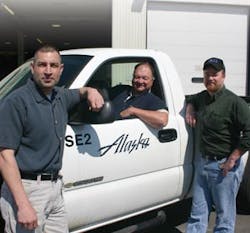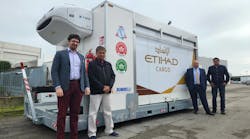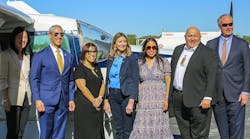When discussing the timeline of biblical and historical events, the terms common to the world are ante Christum; A.C. and before Christ; B.C. When discussing the aviation industry, nearly every conversation now includes “before 9/11” and “after 9/11.” The reality of 9/11 has turned the industry upside down and inside out … causing the airlines to re-evaluate business models, cut costs and review service levels with a fine-tooth comb. Since that infamous day, ground handling services and maintenance outsourcing has become a crucial part of the business model for all airlines, particularly for low-cost and smaller carriers. But there certainly has not been a one size fits all solution.
Contracts…they are a Changin’
Originally named Extreme Line Services, Elite Line Services (ELS) is part of the Five Star Airport Alliance — an airport baggage handling systems and terminal services provider. A fairly young company based in Dallas, ELS has been providing installation, operations and maintenance services for baggage handling systems, passenger boarding bridges, ground support equipment and other airport service needs for 13 years. Although ELS works with several major airlines and airports, the relationship with Alaska Airlines (AS) is quite unique, and perhaps even anomalous. ELS is not a vendor to AA and AA is not a customer; they are partners. Yet just as with any type of relationship, it takes time to get to know one another … it takes time to grow…it takes time to develop into what one hopes will be long-term.
After 9/11, business forecasting changed. Instead of projecting what would happen 15 years hence, the industry was struggling to know what would happen in the next 15 days. Alaska Airlines, like many other airlines, had been looking at the possibility of outsourcing various aspects of their ground handling services and maintenance not too long after 9/11 and with a loss of $15.3 million in 2004; it was no longer a choice.
On September 9, 2004, a new company, a new contract, new processes and almost entirely new employees were in place in both Anchorage and Seattle. When the decision was made to utilize ELS at both locations, a very short window was given to prepare. According to Dewey Kulzer, GSE program director, ELS, “In a matter of weeks, we recruited mechanics from all over the U.S. and got them badged and inplace.” The project was named “Shamu”, a name that still used today for many ELS internal reports. The final result was an ‘unprecedented’ seven-year contract between ELS and Alaska Airlines.
Though not an easy transition, there were a few Alaska Airline employees who “stood the test” and remained with ELS. Mike Vesco, hub manager, ELS, Anchorage and formerly a mechanic for Alaska Airlines, is one of them. Hired on with ELS as a mechanic at the Northwest Airlines GSE maintenance shop, which ELS manages in Anchorage, he was quickly promoted to crew chief for AS, then supervisor of the five outstations and finally hub manager for all of Alaska. “He’s an example of the quality of an individual that exists,” Kulzer says. “You simply need to give them the opportunities … it’s finding the right players for the right seats to build a highly effective team.”
Alaska Airlines owns the equipment and takes care of salaries, budgets and costs, while ELS writes the specifications, recommendations and works directly with the manufacturers and the purchasing department in making final arrangements. ELS staff are invited to Alaska Airlines’ internal bi-weekly meetings in which all aspects of the budget are openly discussed. “[AS] knows every nickel and dime on our books and they are involved every step of the way. It’s a total open book process with AS.” Kulzer says. “In fact, they know all of our costs, our profit and are involved in every step in creating both the yearly ELS budget and in our building an internal AS budget for them. Kulzer states that both parties want everything on top of the table, identifying and exposing all financial matters that affect the partnership, which is built at a senior level between AS and ELS insuring the relationship stays on track and the focus is not diluted.
Kulzer says he wishes this business model would be used in the future, however he indicated that it most likely would only work with a smaller airline like Alaska, a company that prefers to operate in a partnership with the mindset that every employee is an Alaska Airlines employee, even if there is an ELS logo is on their shirt.
Wave of the Future
The EPA deadlines for cleaner running GSE are approaching at different timelines for different parts of the U.S., including the state of Alaska. According to Kulzer, it’s only a matter of time that electric and alternative GSE will become an important and vital aspect of the ground support industry there. However, in Seattle, ELS has already converted all of AS’s cargo operation to Toyota electric forklifts and fast charge. “We worked with Toyota because they know the industry and how and airline works,” Kulzer says. “We are also in the middle of a major project to upgrade all of the Anchorage cargo forklift fleet to electric.”
ELS is currently testing a two hybrid towing units for an unidentified company. “We are absolutely focused on where the environment is going to take the airlines, because we are going to be in front of it,” Kulzer states. ELS also works closely and cooperatively with several other vendors such as TLD and Aerovironment. “These companies not only help us with equipment issues, they help us brainstorm,” Kulzer says. “They have recommended equipment from other companies … in an effort to find the best answer for Alaska Airlines. That’s the kind of people we want to work with.” For example, ELS purchases various GSE from TLD — air conditioners, loaders, air starts and GPUs. “But when it came to their heaters,” Kulzer says, “[TLD] referred us to Spencer Manufacturing and its Coldbuster heater, which they claimed would be better suited for the environment in Alaska.”
All in the Name of Safety
Premier Deicing is another company with which ELS is symbiotically intertwined. Included in the purchase of 11 deicers a year ago and five the year prior, was the agreement for one of Premier’s mechanics to travel to Alaska and service the equipment as well as train the ELS mechanics once a year. “Premier had their hands full,” says Kulzer. “In the past, Alaska Airlines used a palletized deicer which is a Honda motor and a 350-gallon tank that a forklift scoops up with the forks. The person would stand on top of a block that had a little cage around it and would squirt deicing fluid from a hose onto the wing — that’s what the outstations had previously.” Going from a little hose to state-of-the-art technology created the necessity for extensive training. Safety was the key factor in getting AS’s entire system switched over to the Premier Deicers.
“Premier interrupted a portion of their production line to sneak us in because we had to get the deicers on the barges which only run a few months out of the year,” Kulzer explains. “Alaska Airlines was dedicated to turning the deicing into an effective, efficient and safe operation and insisted we get the deicing trucks in place in every outstation before the winter months. We missed getting one of the deicers onto the barge so AS contracted a C130 cargo plane and Premier sent their mechanics to assist with taking the boom off so it would fit into the ‘cargo bird’. They flew it into our most northern outstation, Barrow, Alaska, and put it back together there.”
Go Teams
With every new contract, instead of immediately hiring a new manager and new employees to run that location, ELS sends a “Go Team” — a group of five or six top managers and mechanics selected from various shops within the entire system. “For two to six weeks the “Go Team” will go in and turn a station,” Kulzer says. “It’s a top team with the leadership necessary to get things started, ‘turn the station’ immediately, while interviewing, hiring and training local mechanics.” With multiple “Go Teams” in place, Kulzer has the ability to send a team to get a station started and if necessary, replace it with another team who assist the newly hired management with the development and training on ELS methods and techniques.
According to the ELS folks, every airline will eventually contract out … it’s just a matter of time. However, a contract is all about trust — the type of trust they have with Alaska Airlines. “The major factor is communication,” Kulzer says. “It has never faltered. Integrity is so hard to get and so easy to lose. We make sure we protect our integrity everyday and we are proud.”





